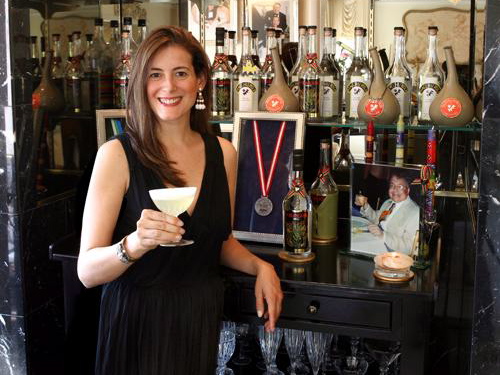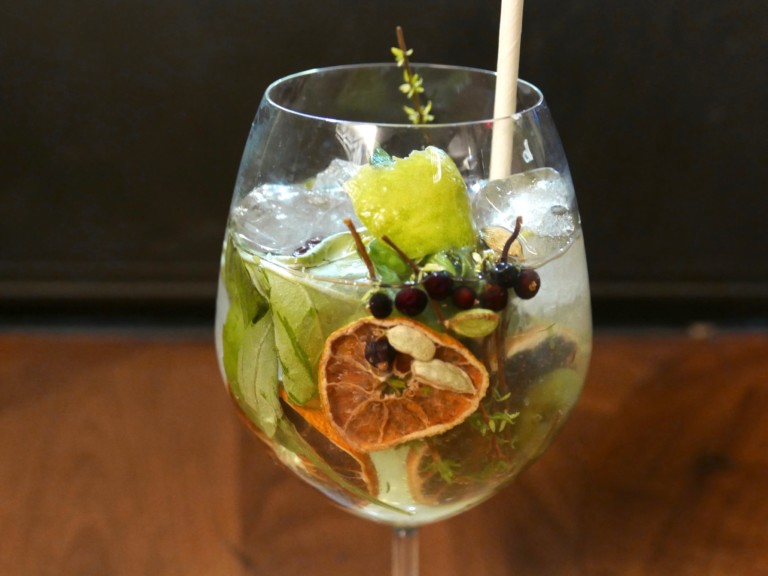Melanie Asher took a circuitous route to distillation. At age seven, the native Peruvian immigrated to D.C., where she skillfully acclimated to the States. She eventually worked on Wall Street, back when the financial sector was still flying high. Asher attended Harvard Business School, honing the skills she’d need to start her own business, Macchu Pisco, which drew on “spiritual” Peruvian traditions. To ensure peak quality, she personally distills each batch of grape-based spirit. We recently met at The Varnish, where Asher explained her background and approach over Pisco Sours.
Josh Lurie: How did you become interested in pisco?
Melanie Asher: Well my parents came to the U.S. when I was very little, and we come from a long line of entrepreneurs, so I used to have – it’s embarrassing to say – but when I moved over here, I was in the seventh grade – and I had a picture of Donald Trump in my locker instead of, like, David Hasselhoff. I’m totally aging myself, but I just said, “I want to start my own pisco company,” when I was twelve. My parents were like, “Oh sure, that’s crazy.” But in honesty I would go home for the holidays, in December, to Peru, and I’d see everyone drinking pisco. Why isn’t everyone drinking pisco in the U.S.? It doesn’t make any sense. This was in the ’80s, so there wasn’t any tequila boom. It was basically vodka, gin, rum and whiskey. They didn’t even have much room, so I said, there’s room in the market for pisco. It just stuck with me. I went to Duke undergrad and did my thesis on liquor, on the temperance and Prohibition movement in France and Peru.
JL: What was your degree in?
MA: I was a history major, but then I went to work on Wall Street and became an investment banker. If I wanted to go into the liquor industry, I needed to figure out if I could make money from this, so I went to work for Solomon Brothers, which became Solomon Smith Barney, which became CitiGroup. Okay, the liquor business is good. I didn’t feel like I was ready to start my own company yet, because I was really young, because I did banking right out of college. I asked my dad, “Should I go work for a liquor company now?” He said, “No, the best thing would be for you to go get your MBA and that way you can really make sure this is what you want to do.” So I went to Harvard Business School and graduated in 2003. The economy was bad, and I said, “You know what, I don’t have kids, I’m not married, why not start my business now?” I went to all these people, all the alumni, and asked to get their money for investment. Everyone’s like, “Just do a vodka. We’ll make our money back. We’ll get a slice of the market. It’ll be great.” I said, “No. I want to do pisco. Being from Peru, I’m very passionate, love my country, and it’s lovely to go back, work there, and give back. I knew when I left when I was seven years old. When we immigrated to the U.S., we came with very little, just from personal reasons. My mother just divorced, so when we came to the U.S., we had very little. For me, something always told me, I want to go back to Peru, I want to go back to Peru. The pisco business really attracted me because it was really something I enjoyed and I thought about it when I was little.
JL: Where did you live in the U.S. when you were growing up?
MA: In D.C., which is why we still have our importing company there.

Macchu Pisco draws on time-tested Peruvian distilling traditions.
JL: Do you have a first pisco memory?
MA: My first, first, first pisco memory is putting pisco in my ice cream. That got me in a little trouble. And then a memorable, memorable pisco memory was when I graduated from business school. We’re from Lima, which is a very close society. Everybody knows each other. When I went back to Peru, in Lima, the grapes are in the south of Lima. So I went to the country, where I didn’t know anybody, and nobody knew me. It’s a desert, and I basically just went around looking for grapes from the farmers. It was very exciting because it was completely exploring the wild frontier. I didn’t know anyone in the area. We had no family there, so I started buying the grapes, hand-selecting the grapes. I found a chemist and an oenologist who helped me distill based on what I thought would be a perfect pisco. The American and European market, they don’t want a traditional, typical pisco that I’d characterize as stinky pisco. They’re local tastes. Peruvians love a pisco that really burns your throat, because culturally, if it doesn’t burn your throat, it’s not a good pisco. Cause it’s like, where’s the alcohol? I wanted to make a gentler pisco that still had alcohol, but was smooth. That’s what I think is a characteristic of Macchu Pisco and La Diablada. It’s very much refined for export markets.
JL: What’s the difference between your piscos?
MA: Macchu Pisco is our single grape varietal pisco, made from one grape. It’s made organically, all naturally. So the slogan is “All the highs without the lows.” You get no hangover. I’m actually the grape stomper. So on the back of the bottle is my name.My sister [Lizzie, also with the company] and I have both polished off one bottle between the two of us and can attest to the no hangover rule.
The La Diablada is our aromatic pisco made from four grapes: quebranta, Italia, toratel and muscatel. It’s much more of a fruiter, floral pisco sour. What I actually recommend the La Diablada for is to drink it straight, or to make a pisco punch with it, because when it’s mixed with fruits, the aromas come out a bit more. The difference is that Macchu Pisco is rested for three months, La Diablada is rested for one year. Macchu Pisco has six kilos of grapes per one kilo, which is the equivalent of six bottles of wine for one bottle of pisco, as opposed to La Diablada, which is eight kilos of grapes per litre, or eight bottles of wine for one bottle of pisco. Because for La Diablada, we do a single grape pressing. We just press the grape once. So it’s like extra virgin olive oil as opposed to virgin olive oil. Both products are made all naturally, but La Diablada has more of a fruity, floral aroma, whereas Macchu Pisco has much more of a macho, earthy, smoky, herbal quality to it.
JL: You have a third variety too?
MA: Yeah, the Musta, and that’s strictly a sipping pisco. Macchu Pisco is a pisco puro. It’s like pure pisco. It means from one grape variety, which is why it’s called puro, like single-malt whiskeys. Pisco puro, and that grape is the quebranta grape. La Diablada is the acholado, or pisco blend. I use four grapes, and we’re the only company to use the muscatel grape in our pisco blend. That’s the original grape that was used in the pisco punch when it came over from Peru to San Francisco during the Gold Rush. But I’ll get into that later. Then the third type of pisco is called Mosto Verde, literally green must, because it’s like a green banana. It’s immature. It’s not ripe yet, because we don’t allow all the sugars in the wine to ferment. So we’re virtually distilling a half-fermented grape juice. That’s our equivalent of Angel’s Share. We waste so much potential alcohol because instead of allowing all that sugar to convert into alcohol, we distill it right away. Therefore, we require twice as much grapes to make one bottle of pisco, as if we allowed it to fully ferment. So it’s much smoother, it’s much more unctuous, it’s more velvety and sweeter.
JL: Why was it important for you to make the pisco personally, instead of hiring somebody to do it?









Blog Comments
Distiller Straight
January 24, 2011 at 9:52 PM
[…] Q&A with distiller Melanie Asher (Macchu Pisco) What I actually recommend the La Diablada for is to drink it straight or to make a pisco punch with it, because when it's mixed with fruits, the aromas come out a bit more. The difference is that Macchu Pisco is rested for three months . […]